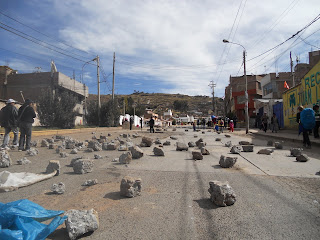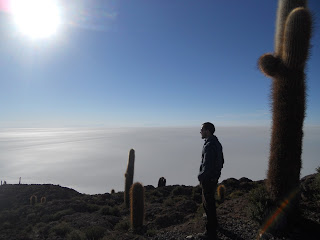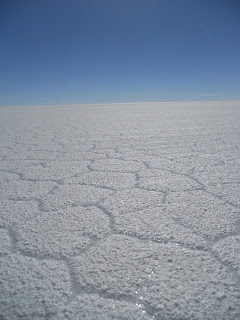The 23rd and 24th May 2011 comprise of 48 hours that Ania and I would probably rather forget. It re-defines the phrase 'difficult border crossing', but I guess there's some comfort to be had in the knowledge that we are not alone in making this epic trip: hundreds and probably thousands of other tourists have had to deal with this in Bolivia and Peru in the past few weeks.
For those of you who don't know: there were major strikes and protests going on at the Bolivian border with Peru, up until last week. All the demonstrations were put on hold because of the election yesterday (5th June) and we're not quite sure what's going on now! At the time though, we knew even less - and anything we did know was hear-say. The biggest issue was anger over a Canadian mining company's plan for a new mine. So there were miners and students protesting, plus I'm sure the usual people without anything to do who like to join in protests (same as in the UK)! I'm all for peaceful protest but I'm sorry to say this wasn't peaceful. So our planned route from Copacabana to Puno - the two towns on either side of Lake Titicaca - was blocked when we wanted to take it. The usual three-hour bus journey was not an option. What follows is what we had to do instead...
We got up at 5:50am on 23rd in order to catch our boat - yes boat - to Peru. We were the first ones to arrive at the tiny shop where we bought our tickets and after some moments of 'Is anyone else coming?...' our group piled into two minibuses and set off for the border. More waiting around and then we got our Bolivian exit stamps pretty quickly once the office opened. The Peruvian side was shut! So now technically not in any country, we walked across boggy ground to our little boat. Our group, 'Grupo de Celia' (named after the woman who sold us the tickets) all got seats, after paying the crew a few Peruvian Soles each. Some others weren't so lucky. That boat was then our world for the next nine and a half hours! Not much to report there, I'm afraid. We read our books (I got through most of The Green Mile by Stephen King) and ate our packed lunch, which we had sensibly packed the previous day!

On arrival in Puno, we all jumped on a bus and were taken as near to the town centre as possible. Vehicles can't go near the blockades, you see. But people can - and go near them we did! We were led through the main square towards the immigration office. We all needed our Peru entry stamps. Our guide led us through the shouting crowd - most of whom just smirked at all the 'gringos' - although a few were intimidating, or at least tried to be. We got our stamps eventually from a very disorganised, ramshackle (and I suspect makeshift) office; and then found our way back to the bus.
Ania and I then bought a bus ticket to Arequipa (our next stop in Peru) for the next day, from the guys on the bus, based on the fact that they'd been so helpful getting us into Peru. This turned out to be a mistake...
We got to our hostel in Puno, 'Los Pinos', at around 7pm and after a quick turnaround, headed out for excellent pizza and a couple of well-earned beers! At one point the protestors rumbled past and the owner of the restaurant closed all the shutters and dimmed the lights. It was like being in a lock-in for ten minutes - except better, because there was also pizza from a proper wood-fire oven! We ate our meal safe in the knowledge that we'd done the hard part!
Or so we thought, but no such luck! The next day, the guy we'd bought our bus ticket from failed to turn up at our hostel for our prearranged pick-up. The woman at the desk in our hostel - who incidentally was super-sweet, very kind and helpful - said she'd heard there were no buses leaving the town. Our hearts sank and we left on foot, eventually catching a rickshaw to the bus station. The terminal was a ghost town and after talking to two policemen, we realised we'd paid well over the odds for our bus tickets: 40 Soles each instead of 15! We gave up trying to get our money back (40 Soles is just under 9 quid - annoying to lose it, but what can you do...) after finding the company's office closed and having no joy phoning the number on our ticket.
With no buses leaving, we instead hooked up with two other couples from Italy and Canada. The plan? To walk out of Puno on foot and catch a bus or taxi to Juliaca, a town just outside of the blockade, from where we hoped to be able to catch a bus to Arequipa.
So off we set, telling our new friends about the dodgy bus tickets. Not even two minutes had passed when who should Ania spot, drinking booze at 8:30 in the morning outside a shack?! The guy who'd sold us the tickets! He looked so busted and we demanded our money back. We got 70 of our 80 Soles back - and had a heated exchange with one of his mates, who stooped so low as to tell us that he hoped the protestors would hurt us. Money safely in hand, we told that arsehole to shut his mouth and walked away! I'm so proud of Ania! She did most of the arguing with her superior Spanish and showed those crooks who was boss!
A few minutes down the road a man approached us and in excellent English told us to make ourselves scarce! He said the protesters were coming and we should sit out of the way - and that he was going to do the same. As he walked away we saw them coming - this is a loud angry mob who haven't just been peacefully marching, they've been throwing stones at vehicles, blocking roads and disrupting tourists (and tourism) for weeks. The six of us sat by the side of the road. A woman then approached. 'You're not safe here,' she said. 'Follow me'. We obeyed and ended up hiding in a public bathroom with her and a couple of other Peruvians! We spent about ten minutes there, during which time the woman advised us to get to a hotel in Puno and wait for a few days! Grateful as we were for the shelter, we decided to leave. The situation hasn't changed in almost a month, why would things be different in a few days?!
With the coast apparently clear we left the bathroom, but then we saw the mob again, coming right for us! We walked quickly, not running, and just managed to avoid them. Thank God they took a different road to us!
We then had to walk for two hours, carrying our 12kg backpacks plus hand luggage, up a massive hill. The roads were covered in rubbish, huge blocks of brick and stone and bits of metal - all designed to stop traffic getting through:
 In the middle of this photo you can see a poster for the election campaign of Keiko Fujimori (the election was on Sunday, it looks like she lost). The slogan reads, 'Seguridad y oportunidades por todo' (security and opportunities for all). I liked the irony of the juxtaposition of the poster with the crap all over the road!
In the middle of this photo you can see a poster for the election campaign of Keiko Fujimori (the election was on Sunday, it looks like she lost). The slogan reads, 'Seguridad y oportunidades por todo' (security and opportunities for all). I liked the irony of the juxtaposition of the poster with the crap all over the road! It was really tough carrying so much up such a steep incline, but we did it eventually with several rests. Every time we thought we'd made it, there was another section of hilly road! I was not best pleased:
It was really tough carrying so much up such a steep incline, but we did it eventually with several rests. Every time we thought we'd made it, there was another section of hilly road! I was not best pleased:Where we came from. Puno town centre, at the bottom of the first huge hill:
 Eventually we were rewarded with clear roads and an estate car. The driver agreed to take us to Juliaca for 25 Soles each. We squeezed in: luggage in the boot, our four new friends in the back and Ania and I sharing the front passenger seat. For two hours! We drove mainly on unsealed, winding roads, but it still beat walking! We made a quick stop at one point. Here we are in the middle of nowhere!
Eventually we were rewarded with clear roads and an estate car. The driver agreed to take us to Juliaca for 25 Soles each. We squeezed in: luggage in the boot, our four new friends in the back and Ania and I sharing the front passenger seat. For two hours! We drove mainly on unsealed, winding roads, but it still beat walking! We made a quick stop at one point. Here we are in the middle of nowhere!
On arrival in Juliaca we caught a four-hour bus (for the correct price of 15 Soles this time!) to Arequipa and a short taxi ride to our hostel. Mission accomplished! A difficult 48 hours to say the least, but we did it! And hey, it makes a great story doesn't it?
















 Our two nights in La Paz were spent with more relaxation, food and wandering. One of the best sights in the city - which incidentally is bigger, noisier, more crowded and far less picturesque than Sucre - is the Witches' Market. We enjoyed browsing the stalls selling llama-wool products, jewellery, the usual tourist crap and bizzarely, dried llama fetuses! Mmmm! Needless to say we did not buy one. We read in one guidebook or leaflet that they are considered good luck and Bolivians buy them to bury under the porch of a new house to bring good fortune to the residents. If you look closely at the picture below, you can see one:
Our two nights in La Paz were spent with more relaxation, food and wandering. One of the best sights in the city - which incidentally is bigger, noisier, more crowded and far less picturesque than Sucre - is the Witches' Market. We enjoyed browsing the stalls selling llama-wool products, jewellery, the usual tourist crap and bizzarely, dried llama fetuses! Mmmm! Needless to say we did not buy one. We read in one guidebook or leaflet that they are considered good luck and Bolivians buy them to bury under the porch of a new house to bring good fortune to the residents. If you look closely at the picture below, you can see one:











 Our guide Miguel really was a legend, and he came through for me big-time when he took me to a hospital in a tiny village called San Juan. I really wasn't expecting much, but the doctor or pharmacist (or whatever he was!) was great and gave me some antibiotics, which worked almost instantly! Hurrah! Thanks, Miguel. If you, dear reader, ever go to Bolivia and do this tour, ask for him to be your guide, he´s fab!
Our guide Miguel really was a legend, and he came through for me big-time when he took me to a hospital in a tiny village called San Juan. I really wasn't expecting much, but the doctor or pharmacist (or whatever he was!) was great and gave me some antibiotics, which worked almost instantly! Hurrah! Thanks, Miguel. If you, dear reader, ever go to Bolivia and do this tour, ask for him to be your guide, he´s fab! For our third and final night we stayed in the best place yet. Ania and I even got a private room! It was a salt hotel on the outskirts of the salt flats. The entire floor was covered in salt and we all splashed out ten Bolivianos (just over a pound) for a hot(ish) shower. We had another good meal and then Wayne, one of the guys from a separate group, taught us all a cool card game called 'Werewolf', which I can honestly say is unlike any other I've ever played! We loved it!
For our third and final night we stayed in the best place yet. Ania and I even got a private room! It was a salt hotel on the outskirts of the salt flats. The entire floor was covered in salt and we all splashed out ten Bolivianos (just over a pound) for a hot(ish) shower. We had another good meal and then Wayne, one of the guys from a separate group, taught us all a cool card game called 'Werewolf', which I can honestly say is unlike any other I've ever played! We loved it! Our fourth and final day was the best of the lot. We set off before sunrise again and almost immediately drove onto the salt. Miles and miles and miles of it, at 3650 metres above sea level! And yes, you can eat it! There was quite a bit of water on the surface and we drove through about a foot of it for ages. We took some great photos courtesy of the reflections:
Our fourth and final day was the best of the lot. We set off before sunrise again and almost immediately drove onto the salt. Miles and miles and miles of it, at 3650 metres above sea level! And yes, you can eat it! There was quite a bit of water on the surface and we drove through about a foot of it for ages. We took some great photos courtesy of the reflections: Sunrise over the water-covered salt:
Sunrise over the water-covered salt: We saw a few of these incredible salt whirls:
We saw a few of these incredible salt whirls: Our first stop that morning was the 'Isla del Pescado', Fish Island! It's home to loads of huge cacti and gives you simply breathtaking views of the Salar de Uyuni. Here´s me looking out on the island. Look at all that white, as far as the eye can see!
Our first stop that morning was the 'Isla del Pescado', Fish Island! It's home to loads of huge cacti and gives you simply breathtaking views of the Salar de Uyuni. Here´s me looking out on the island. Look at all that white, as far as the eye can see! Currently Fish Island's biggest cactus, at nine metres. They grow at about a centimetre a year, making this one roughly 900 years old! The previous biggest cactus on the island was just a few metres away from this one. At twelve metres and about 1200 years old, it looked pretty sorry for itself collapsed on the floor!
Currently Fish Island's biggest cactus, at nine metres. They grow at about a centimetre a year, making this one roughly 900 years old! The previous biggest cactus on the island was just a few metres away from this one. At twelve metres and about 1200 years old, it looked pretty sorry for itself collapsed on the floor! Our cook, Natalia, in traditional Bolivian national dress (complete with cool bowler hat!), serves us breakfast just outside Fish Island. That's Natalie and Johan on the left.
Our cook, Natalia, in traditional Bolivian national dress (complete with cool bowler hat!), serves us breakfast just outside Fish Island. That's Natalie and Johan on the left. Having fun on the salt after breakfast:
Having fun on the salt after breakfast:

 After leaving Fish Island we stopped at the famous Salt Hotel on the Salar itself, saw more great scenery and had a quick lunch in Colchani, a town where they process the salt for our tables!
After leaving Fish Island we stopped at the famous Salt Hotel on the Salar itself, saw more great scenery and had a quick lunch in Colchani, a town where they process the salt for our tables!